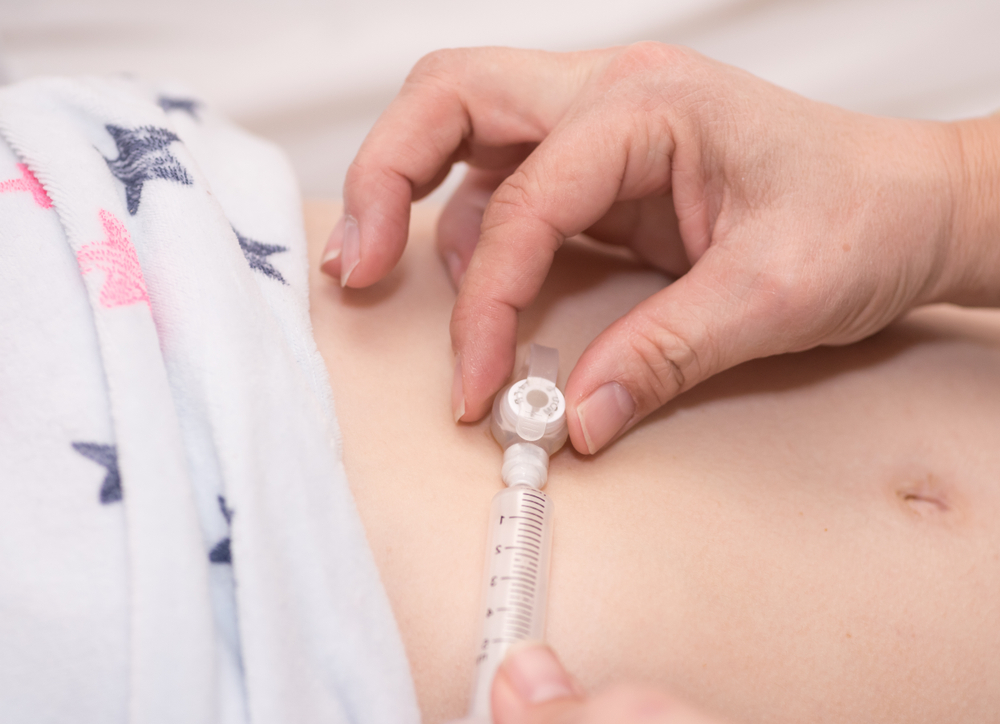Resources and support from ACP are not intended to be a substitute for professional medical advice, diagnosis, or treatment. Always seek the advice of your physician or other qualified health provider with any questions about or related to a medical condition. ACP assumes no responsibility for any injury arising out of or related to any use of related information or for any errors or omissions.
WHAT IS A G-TUBE?
Some kids have medical problems that make it hard for them to get enough nutrition by mouth. A gastrostomy tube (also called a G-tube) is a tube inserted through the belly that brings nutrition directly to the stomach. It’s one of the ways doctors can make sure kids who have trouble eating get the fluid and calories they need.
A surgeon puts in a G-tube during a short procedure called a gastrostomy. The G-tube can stay in place for as long as a child needs it.
Kids who have had a gastrostomy (ga-STROSS-teh-mee) can get back to their normal activities fairly quickly after they have healed.
WHO NEEDS A G-TUBE?
Kids need G-tubes for different kinds of health problems, including:
• Congenital (present at birth) problems of the mouth, esophagus, stomach, or intestines
• Sucking and swallowing disorders (due to premature birth, injury, a developmental delay, or another condition)
• Failure to thrive (when a child can’t gain weight and grow normally)
• Extreme problems with taking medicines
TYPES OF G-TUBES
There are many different types of gastrostomy tubes that may be used to help your child. The type of tube selected depends on each patient’s unique medical condition. Your child’s doctor will determine the best type of G-tube for your child and explain this in detail at the time of the evaluation. Below are two of the most common types of G-tubes to help you understand what to expect. Some names of tubes which may be placed include: AMT mini-one, MIC, MIC-Key, and Cor-Pak.
LOW-PROFILE G-TUBES
One of the most common types of G-tubes is a low-profile tube sometimes called a “button.” This type of tube lays on top of the abdominal wall and is kept in place in the stomach by a water-filled balloon. A special extension tube is attached when administering medications or feedings. During your child’s hospital admission, you will learn how to use, clean and care for the G-tube.
LONG TUBES
Sometimes a longer tube is used instead of the low-profile button. These longer tubes are also surgically placed into the stomach and held in place with either stitches or a water-filled balloon. Sometimes a Hollister dressing is kept in place around a long tube. A Hollister dressing is a large circular dressing that allows the tube to stay in place with a zip lock-type device. If a long tube is the right choice for your child, you will be taught how to use and care for it, as well as, how to keep it secure and change the dressing.
HOW IS A G-TUBE PLACED?
G-tubes can be placed surgically in the operating room, or percutaneously, through a small incision, by a radiologist. Your child’s doctor will determine the best procedure for your child.
SURGICALLY PLACED G-TUBE
If a surgically placed tube is needed, it will be placed by a pediatric surgeon in the operating room. The surgeon will make one or more small incisions in the belly area, then make an opening into the stomach called a stoma. A tube will be placed through the belly opening and into the stomach.
PERCUTANEOUS ENDOSCOPIC GASTROTOMY (PEG) TUB PLACEMENT
A PEG tube is another type of G-tube. A radiologist usually performs this type of tube placement in the Interventional Radiology while your child is asleep.
WHAT HAPPENS BEFORE THE G0TUBE PLACEMENT?
Doctors often order several tests before a child can get a G-tube. The most common test is an X-ray of the upper gastrointestinal (GI) system. This lets the doctor see the upper part of the digestive system. Sometimes the surgeon asks the family to meet with specialists, such as a gastroenterologist, dietitian, or social worker. This is to prepare a care plan so everything will be set up when the child goes home with the G-tube.
To get ready for the procedure, you will need to carefully follow instructions about when your child must stop eating and drinking. When you get to the hospital, the doctor will describe what will happen and answer any questions. The anesthesiology team will ask about your child’s medical history and when your child last ate and drank.
Before the procedure begins, the care team sets up monitors to keep track of your child’s vital signs (like blood pressure and oxygen level) and puts in an intravenous line (IV) to give medicines and anesthesia. Your child will go to the operating room, and you’ll go to a waiting area. A hospital staff member will tell you when the procedure is over.
WHAT HAPPENS AFTER G-TUBE PLACEMENT?
Kids usually stay in the hospital for 1 or 2 days. Most hospitals let a parent stay with their child. While in the hospital, your child will get pain medicine as needed.
The nurses will teach you how to:
• Care for the tube and the skin around it to keep it clean and infection-free.
• Handle potential problems, such as the tube accidentally falling out.
• Give a feeding through the tube. You will also learn what to feed.
• Help your child eat independently if the doctor says it’s OK.
By the time your child is ready to go home, you should have:
• Detailed instructions on home care, including bathing, dressing, physical activity, giving medicines through the tube, and venting (releasing gas from) the tube
• A visit scheduled with a home health care nurse to make sure things are going smoothly
• Follow-up visits scheduled with your doctor to check the tube and your child’s weight
FOLLOW-UP AFTER G-TUBE SURGERY
Your child will be seen for an appointment with general surgery about four to six weeks after being discharged from the hospital. In many instances, the G-tube will be changed at this appointment. Additional follow-ups will be scheduled, if needed.
WHEN TO CALL YOUR DOCTOR
Although G-tubes are generally easy to use without much maintenance, there are some potential problems your child may experience. If you have any concerns about your child’s G-tube, please call the surgeon immediately. They will discuss whether your child should be seen in our clinic or if they require immediate, emergency medical attention. These problems include:
• A dislodged tube
• A blocked tube
• Any signs of infection (including redness, swelling, or warmth at the tube site; discharge that’s yellow, green, or foul-smelling)
• Excessive bleeding or drainage from tube site
• Vomiting or diarrhea that keeps happening
• Trouble passing gas or having a bowel movement
• Pink-red tissue coming out from around the tube
DISLOGEMENT
Most tubes are secured by a balloon inside the abdomen or by stitches, but they can still become dislodged or removed from the stomach. If this happens before your first follow-up appointment, please call your child’s surgeon immediately. If this happens after your first change, a parent/caregiver or trained professional can replace the G-tube. If you have concerns about dislodgement of your child’s tube, please call your child’s surgeon.
LEAKING
Leaking around a G-tube is common. You will learn how to apply a dressing under the tube, like a piece of gauze, in case the G-tube leaks. Sometimes the drainage becomes excessive and will soak the dressing very quickly. If this is the case, call your child’s surgeon or pediatrician to make an appointment to have your child’s G-tube evaluated.
GRANULATION TISSUE
Granulation tissue is typically dark pink or red and is the body’s natural response to the tube. This tissue may cause some leakage and irritation around your child’s G-tube site. Granulation tissue can be treated with topical steroid creams or with cauterization with silver nitrate. If you have a concern about granulation tissue, call your child’s care team to discuss and to determine whether your child needs an appointment for an evaluation.



